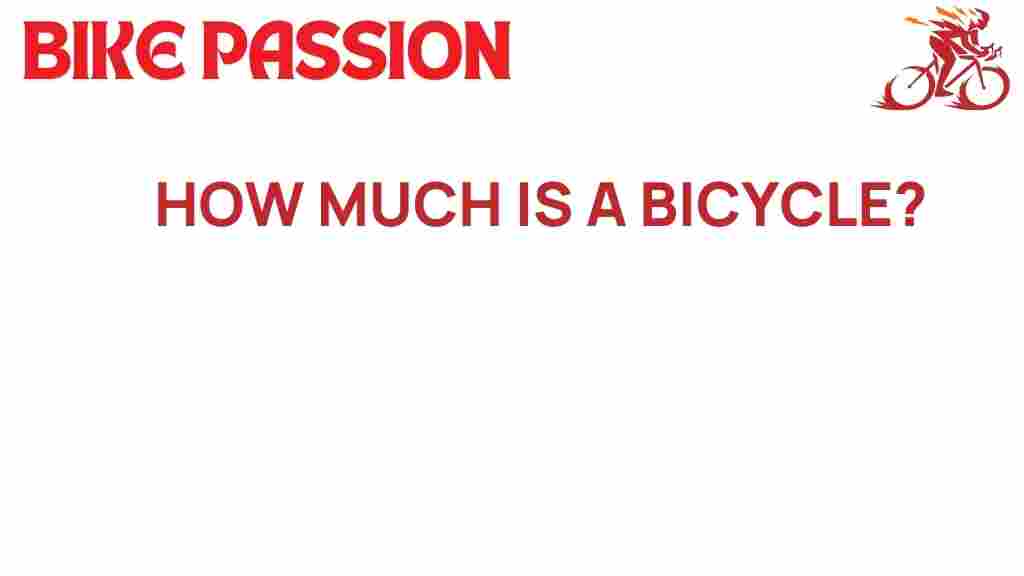Unraveling the True Cost of a Bicycle: What You Need to Know About Bicycle Cost
When considering a new bicycle, many potential cyclists often overlook the full range of bicycle costs involved in the purchasing process. While the upfront price tag is crucial, understanding the ongoing expenses associated with biking is equally important. This comprehensive guide will break down bike pricing, cycling expenses, and offer a purchase guide to help you navigate the complexities of budget biking. Whether you’re a beginner or an experienced cyclist, knowing how to assess the value of your investment in cycling is essential.
Understanding Bicycle Cost
The total bicycle cost includes several components that range from the initial purchase price to long-term maintenance costs. Below, we’ll explore the various elements that contribute to the overall expense of owning a bicycle.
1. Initial Purchase Price
The initial purchase price of a bicycle can vary greatly depending on the type and brand. Here are some common types of bikes and their estimated price ranges:
- Road Bikes: $500 – $10,000
- Mountain Bikes: $300 – $5,000
- Hybrid Bikes: $300 – $1,500
- Electric Bikes: $1,000 – $8,000
- Folding Bikes: $250 – $2,500
The type of bicycle you choose will significantly impact your overall bicycle cost. It’s important to select a bike that fits your cycling needs and budget.
2. Accessories and Gear
When budgeting for a bike, don’t forget to account for essential accessories and gear that enhance your cycling experience. These may include:
- Helmet: $50 – $200
- Lock: $20 – $100
- Lights: $20 – $150
- Clothing: $50 – $300
- Repair Kit: $10 – $50
Investing in quality gear can improve safety and comfort while cycling, making it a worthwhile addition to your initial bicycle cost.
3. Ongoing Maintenance Costs
Maintenance costs are a significant ongoing expense that should not be overlooked in your bicycle cost assessment. Regular maintenance can keep your bike in optimal condition and prolong its lifespan. Here are some typical maintenance costs you may incur:
- Routine Tune-Ups: $50 – $100 per visit
- Tire Replacements: $30 – $100 per tire
- Brake Adjustments: $20 – $50
- Chain Replacement: $20 – $50
To minimize maintenance costs, it’s advisable to learn basic bike repair skills, such as fixing flat tires and adjusting brakes.
Budget Biking: Assessing Your Cycling Investment
Now that we’ve covered the various components of bicycle cost, let’s delve into how to assess your cycling investment effectively. Keeping your budget in mind is key to enjoying your cycling experience without financial strain.
1. Set a Budget
Before you start shopping for a bike, establish a clear budget. Consider all expenses associated with cycling, including:
- Initial purchase price of the bike
- Accessories and gear
- Ongoing maintenance and repair costs
- Insurance, if applicable
Having a budget will help you narrow down your options and avoid overspending.
2. Evaluate Bike Types
Different bike types cater to varied cycling styles and environments. Here’s how to determine which bike type may be best for you:
- Road Bikes: Best for pavement and long-distance cycling.
- Mountain Bikes: Ideal for off-road trails and rugged terrains.
- Hybrid Bikes: A versatile option for both road and light trail cycling.
- Electric Bikes: Great for commuting and reducing the physical strain of cycling.
- Folding Bikes: Perfect for those with limited storage space or who need to take their bike on public transport.
Choosing the right bike type will ensure you get the most value for your cycling investment.
3. Consider Used vs. New Bikes
When assessing your bicycle cost, consider whether to buy a new or used bike. A used bike can save you money, but make sure to inspect it thoroughly for any hidden issues. Here are some tips for buying used:
- Check the frame for any cracks or damage.
- Test the brakes and shifting components.
- Ask about the bike’s maintenance history.
- Negotiate the price based on any repairs needed.
Buying new offers the advantage of warranties and the latest technology but may come with a higher price tag.
Troubleshooting Common Cycling Expenses
As a cyclist, you may encounter unexpected expenses. Here are some common issues and how to address them:
1. Flat Tires
Flat tires are a common issue for cyclists, but they can be easily managed if you carry a repair kit. Here’s what to do:
- Use a tire lever to remove the tire from the rim.
- Inspect the inner tube for punctures.
- Patch the puncture or replace the tube if necessary.
- Reinstall the tire and inflate it to the recommended pressure.
2. Brake Issues
Brake problems can be dangerous and should be addressed immediately. If you experience brake issues:
- Check the brake pads for wear and replace if necessary.
- Adjust the brake cable tension for proper responsiveness.
- If the brakes are still not functioning correctly, visit a professional mechanic.
3. Gear Shifting Problems
If your bike is having trouble shifting gears:
- Inspect the derailleurs for alignment issues.
- Check the cable tension and adjust accordingly.
- Lubricate the chain to ensure smooth shifting.
Conclusion: Making an Informed Cycling Investment
Understanding the true bicycle cost involves much more than just the initial purchase price. By considering all associated cycling expenses, including accessories, maintenance, and potential repairs, you can make a well-informed decision about your cycling investment. Remember to set a budget, evaluate bike types, and consider both new and used options to find the best fit for your needs.
Ultimately, cycling can be a rewarding and healthy activity, and with careful planning and consideration of all costs involved, you can enjoy the journey without financial stress. For more insights into biking products, check out this guide on cycling accessories and explore the vast world of cycling.
Happy riding!
This article is in the category Gear and created by BikePassion Team
